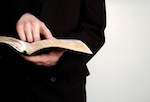 Question: I was recently surprised to discover that some of the people in my church disapprove of Halloween. Why is this?
Question: I was recently surprised to discover that some of the people in my church disapprove of Halloween. Why is this?
Answer: Some Christians object to the observance of Halloween because they find the historical roots of Halloween and its related activities incompatible with God’s calling upon their lives.
Origins – Halloween dates back to pre-Christian England, Ireland, and France where the Druids celebrated their seventh annual Sabbat on October 31. The next day, November 1, marked the ‘return of the dark’ (i.e., the beginning of winter).
During this Sabbat, the Lord of Death “Samhain” was honored with a festival. The Druids hoped that their sacrifices would persuade Samhain to allow the souls of the recently departed to return to their family’s home for a brief visit.
Trick or Treat – The concept of ‘trick of treat’ came from the Druids’ belief that they should have food ready for either the disembodied spirits or for the peasants who went door-to-door in search of festival supplies. Those who offered nothing were threatened with a curse (or with a ‘trick’).
Romanism – In the 7th century, the Roman Church wrestled the Pantheon in Rome out of the hands of the barbarians, turned it into a cathedral, and changed the name from “Pantheon” [all gods] to “The Church of the Blessed Virgin and All Martyrs” so it could become a center for honoring ‘saints’ instead of ‘gods’.
Pope Gregory IV then authorized the change of a May 13 “All Hallow’s Festival” to November 1 to replace the Feast of Samhain. The feast began the night before (October 31) and was therefore called “All Hallows Eve”.
In other words, rather than requiring the heathen to forsake their paganism and accept Christianity, the Roman Church simply ‘baptized’ the existing pagan feast.
Jack-o-Lanterns – Today we carve out a pumpkin, but in pagan Europe it was a turnip, large beet, potato, rutabaga or even a skull with a candle in it. The Druids hoped that these lights would either lead the good spirits back to their homes or frighten the evil spirits away.
Witches – The word ‘witch’ comes from the Anglo-Saxon ‘Wicca’ which is the religion of those who practice magic. The witch’s broomstick was actually a phallic symbol which she would mount and then leap around the fields to ‘teach’ the crops how high to grow.
Black Cats – These critters have always been either feared or revered by superstitious people. The Celts had a particular fear of black cats; believing them to be either ‘the familiars’ of witches or actual humans who had been changed into feline form through witchery. Therefore, black cats were thrown alive into the festival fires or thrown off buildings.
Bon-fires – Fire rites were also an important part of the Druid’s new year feast; where the old ‘sacred fire’ was allowed to go out so that the new one could be kindled. These fires were thought to rejuvenate the waning sun and aid in banishing evil spirits.
Apple Bobbing – When the Celts were conquered by Rome, they adopted some of the old Roman practices. The goddess of orchards and harvest was named Pomona and her ‘sacred fruit’ was the apple. Bobbing or ‘snapping’ for them was an ancient method of divination.
In both the Old and New Testaments, God calls his people to avoid all things related to paganism and witchery (Deuteronomy 18:9-14 and 2 Corinthians 6:11-18). This is why some Christians condemn Halloween.
